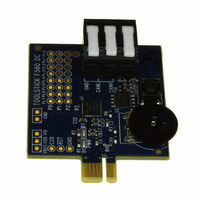TOOLSTICK560DC Silicon Laboratories Inc, TOOLSTICK560DC Datasheet - Page 95

TOOLSTICK560DC
Manufacturer Part Number
TOOLSTICK560DC
Description
DAUGHTER CARD TOOLSTICK F560
Manufacturer
Silicon Laboratories Inc
Series
ToolStickr
Type
MCUr
Specifications of TOOLSTICK560DC
Contents
Daughter Card
Processor To Be Evaluated
C8051F55x, C8051F56x, C8051F57x
Interface Type
USB
Operating Supply Voltage
2.7 V to 3.6 V
Lead Free Status / RoHS Status
Lead free / RoHS Compliant
For Use With/related Products
C8051F55x, C8051F56x, C8051F57x
For Use With
336-1345 - TOOLSTICK BASE ADAPTER336-1182 - ADAPTER USB DEBUG FOR C8051FXXX
Lead Free Status / Rohs Status
Lead free / RoHS Compliant
Other names
336-1719
- Current page: 95 of 302
- Download datasheet (3Mb)
C8051F55x/56x/57x
12. Special Function Registers
The direct-access data memory locations from 0x80 to 0xFF constitute the special function registers
(SFRs). The SFRs provide control and data exchange with the C8051F55x/56x/57x's resources and
peripherals. The CIP-51 controller core duplicates the SFRs found in a typical 8051 implementation as well
as implementing additional SFRs used to configure and access the sub-systems unique to the
C8051F55x/56x/57x. This allows the addition of new functionality while retaining compatibility with the
MCS-51™ instruction set. Table 12.3 lists the SFRs implemented in the C8051F55x/56x/57x device family.
The SFR registers are accessed anytime the direct addressing mode is used to access memory locations
from 0x80 to 0xFF. SFRs with addresses ending in 0x0 or 0x8 (e.g., P0, TCON, SCON0, IE, etc.) are bit-
addressable as well as byte-addressable. All other SFRs are byte-addressable only. Unoccupied
addresses in the SFR space are reserved for future use. Accessing unoccupied addresses in the SFR
space will have an indeterminate effect and should be avoided. Refer to the corresponding pages of the
data sheet, as indicated in Table 12.3, for a detailed description of each register.
12.1. SFR Paging
The CIP-51 features SFR paging , allowing the device to map many SFRs into the 0x80 to 0xFF memory
address space. The SFR memory space has 256 pages . In this way, each memory location from 0x80 to
0xFF can access up to 256 SFRs. The C8051F55x/56x/57x family of devices utilizes three SFR pages:
0x00, 0x0C, and 0x0F. SFR pages are selected using the Special Function Register Page Selection regis-
ter, SFRPAGE (see SFR Definition 11.3). The procedure for reading and writing an SFR is as follows:
1. Select the appropriate SFR page number using the SFRPAGE register.
2. Use direct accessing mode to read or write the special function register (MOV instruction).
12.2. Interrupts and SFR Paging
When an interrupt occurs, the SFR Page Register will automatically switch to the SFR page containing the
flag bit that caused the interrupt. The automatic SFR Page switch function conveniently removes the bur-
den of switching SFR pages from the interrupt service routine. Upon execution of the RETI instruction, the
SFR page is automatically restored to the SFR Page in use prior to the interrupt. This is accomplished via
a three-byte SFR Page Stack . The top byte of the stack is SFRPAGE, the current SFR Page. The second
byte of the SFR Page Stack is SFRNEXT. The third, or bottom byte of the SFR Page Stack is SFRLAST.
Upon an interrupt, the current SFRPAGE value is pushed to the SFRNEXT byte, and the value of
SFRNEXT is pushed to SFRLAST. Hardware then loads SFRPAGE with the SFR Page containing the flag
bit associated with the interrupt. On a return from interrupt, the SFR Page Stack is popped resulting in the
value of SFRNEXT returning to the SFRPAGE register, thereby restoring the SFR page context without
software intervention. The value in SFRLAST (0x00 if there is no SFR Page value in the bottom of the
stack) of the stack is placed in SFRNEXT register. If desired, the values stored in SFRNEXT and SFR-
LAST may be modified during an interrupt, enabling the CPU to return to a different SFR Page upon exe-
cution of the RETI instruction (on interrupt exit). Modifying registers in the SFR Page Stack does not cause
a push or pop of the stack. Only interrupt calls and returns will cause push/pop operations on the SFR
Page Stack.
On the C8051F55x/56x/57x devices, vectoring to an interrupt will switch SFRPAGE to page 0x00, except
for the CAN0 interrupt which will switch SFRPAGE to page 0x0C.
Rev. 1.1
95
Related parts for TOOLSTICK560DC
Image
Part Number
Description
Manufacturer
Datasheet
Request
R

Part Number:
Description:
KIT TOOL EVAL SYS IN A USB STICK
Manufacturer:
Silicon Laboratories Inc
Datasheet:

Part Number:
Description:
TOOLSTICK DEBUG ADAPTER
Manufacturer:
Silicon Laboratories Inc
Datasheet:

Part Number:
Description:
TOOLSTICK BASE ADAPTER
Manufacturer:
Silicon Laboratories Inc
Datasheet:

Part Number:
Description:
TOOLSTICK DAUGHTER CARD
Manufacturer:
Silicon Laboratories Inc
Datasheet:

Part Number:
Description:
TOOLSTICK DAUGHTER CARD
Manufacturer:
Silicon Laboratories Inc
Datasheet:

Part Number:
Description:
TOOLSTICK DAUGHTER CARD
Manufacturer:
Silicon Laboratories Inc
Datasheet:

Part Number:
Description:
TOOLSTICK PROGRAMMING ADAPTER
Manufacturer:
Silicon Laboratories Inc
Datasheet:

Part Number:
Description:
TOOLSTICK DAUGHTER CARD
Manufacturer:
Silicon Laboratories Inc
Datasheet:

Part Number:
Description:
KIT STARTER TOOLSTICK
Manufacturer:
Silicon Laboratories Inc
Datasheet:

Part Number:
Description:
KIT UNIVERSITY TOOLSTICK STARTER
Manufacturer:
Silicon Laboratories Inc
Datasheet:

Part Number:
Description:
DAUGHTER CARD TOOLSTICK F330
Manufacturer:
Silicon Laboratories Inc
Datasheet:

Part Number:
Description:
CARD DAUGHTER UNIVRSTY TOOLSTICK
Manufacturer:
Silicon Laboratories Inc
Datasheet:

Part Number:
Description:
DAUGHTER CARD TOOLSTICK F582
Manufacturer:
Silicon Laboratories Inc
Datasheet:

Part Number:
Description:
DAUGHTER CARD TOOLSTICK F500
Manufacturer:
Silicon Laboratories Inc
Datasheet:

Part Number:
Description:
DAUGHTER CARD TOOLSTICK F540
Manufacturer:
Silicon Laboratories Inc
Datasheet:










